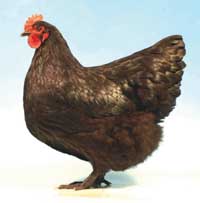Mating Up After all the poultry have passed the above tests and are considered up to Standard and fit for breeding, the question arises of how many females should run with a male. With breeding, there is no hard and fast rule about this mating ratio. The breeder’s target is quality rather than quantity day-old chicks. Thus many breeds, especially true bantams, are simply pair mated (one male to one female) or trio mated (one male to two females). This is advantageous for pedigree records. In the large light breeds they will be mated in pens of 6 or 7 birds, the heavy breeds with 2 or 3 hens. Minor faults in one individual may be balanced by similar extra good points in the opposite sex. Having put the stock breeders together, eggs should be checked for shape, size, texture and colour. The better the egg, the more chance it has of producing a robust chick, if fertile. If egg shape and texture are neglected, the strain will gradually deteriorate until there are more weak eggs than there are good ones.
|




